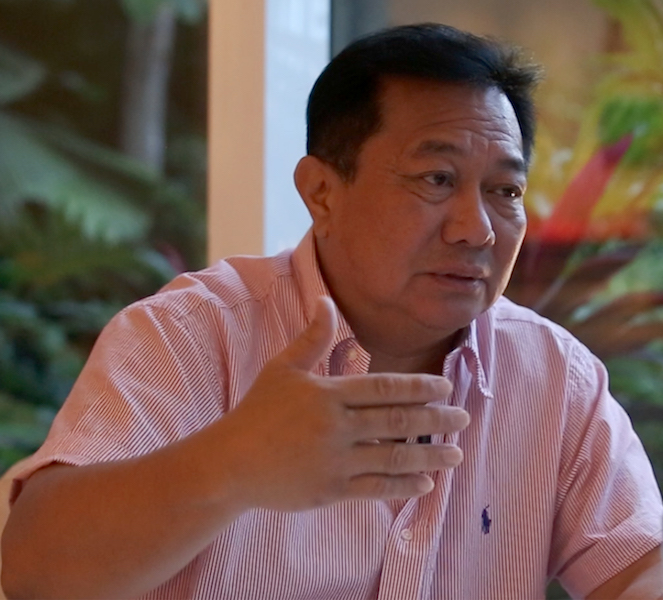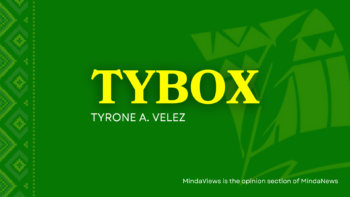DAVAO CITY (Mindanews / 28 March) — Fourteen states — seven in Luzon, five in Mindanao, two in the Visayas — will comprise the future Federal Republic of the Philippines, with Negros as seat of its central government
Of the 14 states, there will be two Moro states in Mindanao and two states for Indigenous Peoples (IPs) — one in Mindanao and another in the Cordillera.
This sums up f Speaker Pantaleon Alvarez’ response when MindaNews asked him about his vision of a Federal Philippines late Sunday afternoon.
 Speaker Pantaleon Alvarez envisions a Federal Philippines comprising 14 states — seven in Luzon, two in the Visayas and five in Mindanao, with Negros as the seat of the Central Government. MindaNews photo by MANMAN DEJETO
Speaker Pantaleon Alvarez envisions a Federal Philippines comprising 14 states — seven in Luzon, two in the Visayas and five in Mindanao, with Negros as the seat of the Central Government. MindaNews photo by MANMAN DEJETO
Asked if this vision is shared by his party mates at the Partido ng Demokratikong Pilipino (PDP), Alvarez replied: “I don’t know but I will really fight for it.”
Senate President Aquilino Pimentel III, PDP party president, envisions a Federal Philippines comprising 11 states, with one Moro state out of three states in Mindanao. President Rodrigo Duterte, on the other hand, has not described his future Federal Philippines except to say it has to have “a strong President” like France.
Alvarez said the five states of Mindanao will be Eastern Mindanao comprising the Davao and Caraga regions; Western Mindanao comprising Zamboanga to Surigao; the two Moro states — the island provinces of Basilan, Sulu and Tawi-tawi, and the mainland provinces of Maguindanao and Lanao del Sur; and the State of Indigenous Peoples.
Alvarez said there are two “most important considerations” in establishing a state: viability– if it can survive economically, and territorial jurisdiction or the land area.
“Of course there will be other considerations,” he said, adding that “when we divide Mindanao, I would suggest we do not divide it by regions.”
He said Caraga is one of the poorest regions in Mindanao and can join the Davao region into the Eastern Mindanao state because the Davao region “can carry, subsidize the government of Caraga.”
Western Mindanao will comprise Zamboanga to Surigao, including the Misamis provinces and “maybe Lanao del Norte.” But for Bukidnon, located in the central part of Mindanao, Alvarez said, “hindi ko alam kung saan pupunta, kung sa Eastern o sa Western” (I don’t know where it will go — if Eastern or Western).
He said the Lumads (Indigenous Peoples or IPs) should have their own state because “why do we exclude the IPs?”
He acknowledged that the Lumads are spread across Mindanao but explained that even if their territories are not contiguous, “as long as they are under one administrative region, kahit hindi contiguous, okay lang yan. Enclaves, enclaves. Then meron silang sariling state governed by their own culture and tradition.”
“We have to address yung diversity ng mga tao,” he stressed.
As for the seat of the IP State, Alvarez said it could be in Agusan which has a substantial population of Lumads, or whatever is decided upon by the Lumads. He said the IP State will be able to survive by applying “the Malaysian formula.”
“Meron silang equalization fund so yan manggagaling sa Federal Government para sinu-subsidize hanggang makabangon yan. The Federal Government will take care of them hanggang umahon yan,” the Speaker said.
“I myself am part of the IP,” Alvarez said, adding he was baptized by the Manobo of Agusan as one of them.
The Speaker explained Visayas will be divided into two states: Eastern and Western Visayas. “We cannot allow Region 8 (the present Eastern Visayas) to be a state kasi mahirap eh. Samar-Leyte.” He said this region could join Cebu and Bohol to comprise Eastern Visayas State.
Western Visayas State, comprising Negros and Panay islands, would not be a problem because it is rich, he siad.
Alvarez is proposing that the seat of the Federal Government would be in Negros but could not specify where in Negros.
“Anywhere. Basta Negros. Why? Because Negros is accessible to Mindanao, accessible to Luzon and accessible to neighboring islands in the Visayas. Look at the map. To connect Mindanao to Negros, you only have to ride RORO Dumaguete (Visayas) to Dapitan (Mindanao) ang you are connected.”
To get to Cebu, one can also take the RORO, he said, adding a bridge could even be built to connect the islands. “In fact, pwedeng gawan ng tulay eh. Yung Don Carlos, basta may shortest distance. Tapos magpunta ka naman ng Manila, ang gagawin lang, Western Nautical Highway. Pag cross mo from Mindoro to Caticlan, deretso ka na ng Panay. Another RORO, ayan na. Bacolod ka na,” Alvarez explained.
Under his proposal, Malacanan Palace, the Speaker said, will just be a “tourist destination” and “historical (site).”
“Landmark na lang talaga siya and I don’t think it’s healthy to maintain Manila as the seat of government,” he said, noting that in other countries, the seats of government have been transferred to other areas.
Alvarez said the shift from a unitary system of government to federal is also a shifting of paradigms. “It has to be revolutionary in nature.”
According to Alvarez, Luzon will have seven states: Bicol, Southern Tagalog, National Capital Region or Metro Manila, MiMaRoPa (Mindoro, Romblon, Marinduque, Palawan), Central Luzon, Ilocos and “another state for the IPs” in the Cordillera.
“May IP (State) sila doon (Luzon). May IP tayo dito (Mindanao),” he added.
Fourteen states will comprise Federal Philippines. “That’s why I have 14 deputy speakers. In preparation…,” he said. (Carolyn O. Arguillas / MindaNews)
